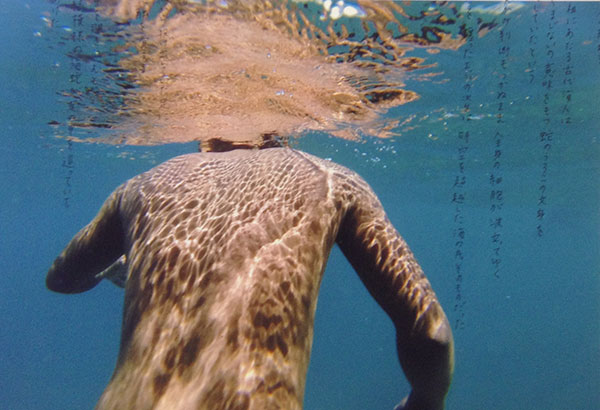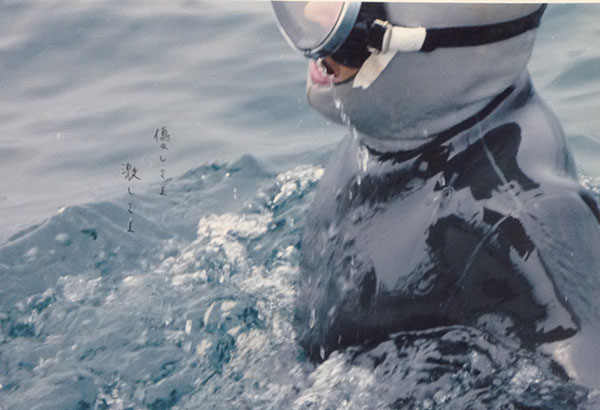Free diving
Terue Yamauchi’s “Human Seascape” is an exhibition of photographs, texts, drawings and a video work developed during artist residencies in Japan, Korea and the Philippines. The residencies involved research of fishing cultures, specifically free-diving: a traditional method of fishing where divers go underwater for minutes at a time without diving gear or oxygen tanks.
It’s a remarkably quiet and effortless show. Located in a corner room at the end of a huge hall inside the University of the Phillipines-Diliman’s Bulwagan ng Dangal, the exhibition feels modest in size and structure but is absorbing in its restraint and earnestness — things often incongruous with most of contemporary art.

Photographs line the walls evenly at eye level each accompanied by white pieces of paper about the same size. Printed on the paper is a direct translation of the Japanese script written furtively on the coupled photograph. The texts are anecdotes and observations of the artist on the lives of the divers. They also contain reflections on her own practice and the inevitable confluence of maritime cultures across countries (“Wearing the tattoo of light, Edgie looked like a people of the sea existing beyond time and space”).
The relationship between image and text is often oblique, as in one photograph where we hone in on a diver’s chest, the sheen of her gray wetsuit lost in the rush of water her body has created upon breaking the surface; written in ink, camouflaged among the waves, is the phrase “dear tenderness; dear severity.” The Japanese artist’s thoughtful (and sometimes sentimental) commentary doesn’t impose meaning. In fact meaning here seems to be incidental and deeply personal. She seems to tell us: the affect (dating) is there, the stories are there — I leave it up to you.

A picture of a bobbing head in the middle of the sea recalls that of an odd sea creature placed under the sun on a wooden plank. The images are laden with this sort of calm fortuity and mediation. We see the divers in action, heaving, gasping for air as they resurface. It appears painful but also euphoric, a sense of profound relief after breathlessness — really, a few breaths short of death. Upon closer look we realize that some of the photographs have lines and curves drawn on them that spill out of the image onto the white field bordering it.
This playful gesture is repeated at the center of the exhibition space where drawings of the sea by Edgie, Louijie and other divers are mounted on freestanding walls. We now see that some of them are actually quite young. The drawings, together with photographs of the divers in their houses and at work, remind us that while the sea has become fodder for many artists, it is still very much home, survival and material resource for a majority of the poor whichever culture they belong. While the tradition of freediving easily lends itself to mushy symbolism, we are also called to resist empty romanticism and recognize the risk and instability of the fishing communities who rely on this practice.
Yamauchi is also unabashedly forthright about her own role as artist-documenter. A memorable text written on a photograph of a diver, whose head we can barely make out in the middle of the sunlight and froth, talks of how the artist sees herself as a participant in her own project:
“The words like ‘cultural exchange’ have been so overused in recent years. Words without actual experience or action carry little or no value that only leave shady, empty sound behind.
“I was in the middle of heaving sea with Omoni of the Onpyungri.
“Then it occurred to my mind that real human exchange may be about individuals flowing together in the present current while directly interacting with each other without avoiding possible friction.
“If so, how precious and yet difficult that would be. ”
Most artists who have used the sea either as enduring metaphor or formal device have assumed that the sea is and should always be unquestionably massive, wild and overwhelming. There is also a strong sense of the artwork’s (or, perhaps, the artist’s) self-regard when we see depictions of the sea that willfully place the looker in a position of smallness in the face of monumental tide.
This self-critical, ruminative moment in Yamauchi’s work recalls all these; all our past visions of the sea and how artists have played their part in giving meaning to cultures and traditions associated with it. How are cultures “exchanged” anyway? And what does it mean to take part in the transfer of knowledge and faith?
The exhibition suggests an image of a sea that is a little less hostile and enigmatic. By accentuating affinities in method and shared beliefs, Yamauchi provides a frame toward discerning others and a means for connecting disparate worlds that we have too often taken for granted.
* * *
The author is the winner of the 2015 Ateneo Art Awards-Purita Kalaw-Ledesma Prize for Art Criticism.


















